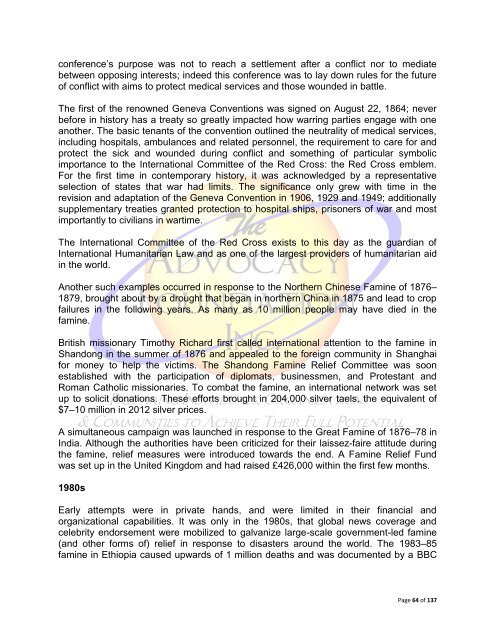The Theology of Missions
The Theology of Missions
The Theology of Missions
Create successful ePaper yourself
Turn your PDF publications into a flip-book with our unique Google optimized e-Paper software.
conference’s purpose was not to reach a settlement after a conflict nor to mediate<br />
between opposing interests; indeed this conference was to lay down rules for the future<br />
<strong>of</strong> conflict with aims to protect medical services and those wounded in battle.<br />
<strong>The</strong> first <strong>of</strong> the renowned Geneva Conventions was signed on August 22, 1864; never<br />
before in history has a treaty so greatly impacted how warring parties engage with one<br />
another. <strong>The</strong> basic tenants <strong>of</strong> the convention outlined the neutrality <strong>of</strong> medical services,<br />
including hospitals, ambulances and related personnel, the requirement to care for and<br />
protect the sick and wounded during conflict and something <strong>of</strong> particular symbolic<br />
importance to the International Committee <strong>of</strong> the Red Cross: the Red Cross emblem.<br />
For the first time in contemporary history, it was acknowledged by a representative<br />
selection <strong>of</strong> states that war had limits. <strong>The</strong> significance only grew with time in the<br />
revision and adaptation <strong>of</strong> the Geneva Convention in 1906, 1929 and 1949; additionally<br />
supplementary treaties granted protection to hospital ships, prisoners <strong>of</strong> war and most<br />
importantly to civilians in wartime.<br />
<strong>The</strong> International Committee <strong>of</strong> the Red Cross exists to this day as the guardian <strong>of</strong><br />
International Humanitarian Law and as one <strong>of</strong> the largest providers <strong>of</strong> humanitarian aid<br />
in the world.<br />
Another such examples occurred in response to the Northern Chinese Famine <strong>of</strong> 1876–<br />
1879, brought about by a drought that began in northern China in 1875 and lead to crop<br />
failures in the following years. As many as 10 million people may have died in the<br />
famine.<br />
British missionary Timothy Richard first called international attention to the famine in<br />
Shandong in the summer <strong>of</strong> 1876 and appealed to the foreign community in Shanghai<br />
for money to help the victims. <strong>The</strong> Shandong Famine Relief Committee was soon<br />
established with the participation <strong>of</strong> diplomats, businessmen, and Protestant and<br />
Roman Catholic missionaries. To combat the famine, an international network was set<br />
up to solicit donations. <strong>The</strong>se efforts brought in 204,000 silver taels, the equivalent <strong>of</strong><br />
$7–10 million in 2012 silver prices.<br />
A simultaneous campaign was launched in response to the Great Famine <strong>of</strong> 1876–78 in<br />
India. Although the authorities have been criticized for their laissez-faire attitude during<br />
the famine, relief measures were introduced towards the end. A Famine Relief Fund<br />
was set up in the United Kingdom and had raised £426,000 within the first few months.<br />
1980s<br />
Early attempts were in private hands, and were limited in their financial and<br />
organizational capabilities. It was only in the 1980s, that global news coverage and<br />
celebrity endorsement were mobilized to galvanize large-scale government-led famine<br />
(and other forms <strong>of</strong>) relief in response to disasters around the world. <strong>The</strong> 1983–85<br />
famine in Ethiopia caused upwards <strong>of</strong> 1 million deaths and was documented by a BBC<br />
Page 64 <strong>of</strong> 137

















